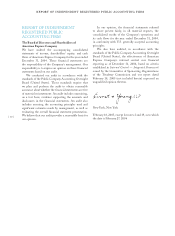American Express 2006 Annual Report Download - page 62
Download and view the complete annual report
Please find page 62 of the 2006 American Express annual report below. You can navigate through the pages in the report by either clicking on the pages listed below, or by using the keyword search tool below to find specific information within the annual report. [ 60 ]
2006 fi nancial review
american express company
AIRLINE INDUSTRY MATTERS
Historically, the Company has not experienced
significant revenue declines when a particular airline
scales back or ceases operations due to a bankruptcy
or other financial challenges. This is because volumes
generated by that airline are typically shifted to other
participants in the industry that accept the Company’s
card products. Nonetheless, the Company is exposed to
business and credit risk in the airline industry primarily
through business arrangements where the Company
has remitted payment to the airline for a cardmember
purchase of tickets that have not yet been used or
“flown.” In the event that the cardmember is not able to
use the ticket and the Company, based on the facts and
circumstances, credits the cardmember for the unused
ticket, this business arrangement creates a potential
exposure for the Company. This credit exposure is
included in the maximum amount of undiscounted
fut ure pay ments disclosed in Note 11 to the Consol idated
Financial Statements. Historically, this type of exposure
has not generated any significant losses for the Company
because an airline operating under bankruptcy protection
needs to continue accepting credit and charge cards and
honoring requests for credits and refunds in the ordinary
course of its business. Typically, as an airline’s financial
situation deteriorates, the Company delays payment to
the airline thereby increasing cash withheld to protect
the Company in the event the airline is liquidated. The
Company’s goal in these distressed situations is to hold
sufficient cash over time to ensure that upon liquidation,
the cash held is equivalent to the credit exposure related
to any unused tickets.
There has been some speculation that there will be
consolidation in the airline industry, both in the United
States and internationally. While the Company would
not expect its merchant relationships to change in the
event of consolidation, it is possible that the Company’s
co-brand relationships might be affected if one of the
Company’s partners merged with an airline that had a
different co-brand partner.
As part of Delta Air Lines’ (Delta) decision to file
for protection under Chapter 11 of the Bankruptcy
Code, the Company lent funds to Delta as part of
Delta’s post-petition, debtor-in-possession financing
under the Bankruptcy Code. At December 31, 2006,
the remaining principal balance was $176 million and
is scheduled to be repaid on a monthly basis through
September 2007. This post-petition facility continues
to be structured as an advance against the Company’s
obligations to purchase Delta SkyMiles rewards points
under the Company’s co-brand and Membership
Rewards agreements.
Given the depth of the Company’s business
relationships with Delta through the SkyMiles Credit
Card and Delta’s participation as a key partner in the
Company’s Membership Rewards program, in the
event Delta’s reorganization under the bankruptcy laws
is not successful or otherwise negatively impacts the
Company’s relationship with Delta, the Company’s
future financial results could be adversely impacted.
As previously disclosed, American Express’ Delta
SkyMiles Credit Card co-brand portfolio accounts for
less than 10 percent of the Company’s worldwide billed
business and less than 15 percent of worldwide managed
lending receivables.
OTHER REPORTING MATTERS
ACCOUNTING DEVELOPMENTS
See the Recently Issued Accounting Standards section
of Note 1 to the Consolidated Financial Statements.
GLOSSARY OF SELECTED TERMINOLOGY
Asset securitizations — Asset securitization involves
the transfer and sale of receivables or loans to a special
purpose entity, which is a separate legal entity, created
for the securitization activity, typically a trust. The trust,
in turn, issues securities, commonly referred to as asset-
backed securities, that are secured by the transferred
receivables or loans. The trust uses the proceeds from
the sale of such securities to pay the purchase price for
the underlying receivables or loans.
Average discount rate — Represents discount revenue
from all card spending (proprietary and Global Network
Services) at merchants divided by all billed business
(proprietary and Global Network Services) generating
discount revenue at such merchants. Only merchants
acquired by the Company are included in the computation.
Discount rates have been restated on a historical basis
from those previously disclosed, primarily to retain in
the computation the Global Network Services partner
portion of the discount revenue, as well as the Company’s
portion of discount revenue.
Basic cards-in-force — Represents the number of cards
issued and outstanding to the primary account owners
and does not include additional supplemental cards
issued on such accounts.
Billed business — Represents the dollar amount of
charges on all American Express cards; also referred to
as spend or charge volume. Proprietary billed business
includes charges made on the Company’s proprietary
























